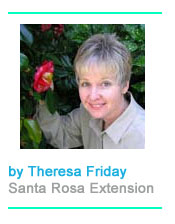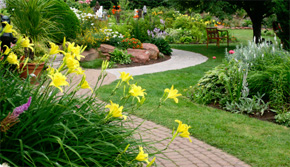Fall Gardening: Time To Tackle The Chaos And Prepare For Winter
October 2, 2010
Towards the end of the growing season, many landscapes are overgrown and untidy. Allowing plants to tower over others can mean the demise of the smaller plant. It’s time to tackle the chaos and prepare for winter.
 First and foremost, take a good look at your landscape. If a plant has outgrown its allotted space, perhaps it was the wrong plant in the wrong place. Avoid these types of problems by becoming familiar with a plant before you plant it. While you can try to control the size of the plant to fit its space, it will never be a happy, stress-free plant.
First and foremost, take a good look at your landscape. If a plant has outgrown its allotted space, perhaps it was the wrong plant in the wrong place. Avoid these types of problems by becoming familiar with a plant before you plant it. While you can try to control the size of the plant to fit its space, it will never be a happy, stress-free plant.
Information on the mature size of a plant and their site requirements can be found in several Extension publications. The Florida-Friendly Landscaping™ (FFL) “Guide to Plant Selection and Landscape Design” is intended for homeowners who want to take the next step and design their own Florida-Friendly landscapes. Included in this book is information on landscape design strategies, a landscape planning worksheet, and the FFL plant list containing many of the UF/IFAS recommended Florida-Friendly plants for each region of the state. It’s available online by clicking here.
Even in a well-planned landscape, though, the gardener’s controlling influence is important. The most useful methods for dealing with especially enthusiastic plants are removing, pruning, supporting or creating barriers to prevent unwanted spreading.
Removing and replacing
Autumn is an excellent time to establish shrubs and trees. Consider removing oversized plants and replacing them with carefully chosen ones that will happily fit within your defined boundaries. Plants that are installed late in the year will develop strong roots systems before hot weather arrives next spring.
Pruning
 When it comes to pruning, it’s good to remember that it’s better to prune lightly occasionally as needed, than to allow a plant to get way overgrown and then cut it back severely. A few prudent snips here and there will help keep more vigorous plants from overwhelming their less vigorous neighbors.
When it comes to pruning, it’s good to remember that it’s better to prune lightly occasionally as needed, than to allow a plant to get way overgrown and then cut it back severely. A few prudent snips here and there will help keep more vigorous plants from overwhelming their less vigorous neighbors.
Emphasis must be placed on the word “light.” It’s important to remember that late summer pruning may stimulate an additional flush of shoot growth on species which flush several times each year. These shoots could be damaged by an early frost.
Supporting
Another technique to improve the look of an overgrown landscape is staking. Staking or otherwise supporting plants keeps them from leaning or falling over onto others. It helps the tall plant look better, and obviously benefits the plants that would otherwise be covered. The stake should be tall enough to do the job but not be too obvious.
Stakes may simply be placed in such a way that the plant is supported by leaning up against it. On the other hand, it may be necessary to tie the plant to the stake. Typically, twine or plastic ties are used for this purpose. Make sure you tie the lower and upper parts of the plant to the stake to provide proper support.
Other techniques for support include tying twine in a loop all the way around a plant, using a wire cage – this is best done early in the growing season to allow the plant to grow into it – tying a plant to a sturdier, nearby plant or using one of the commercially available support systems.
Barriers
Many perennials and tropical plants spread by underground structures called rhizomes. If growth shows up outside the area you’ve allotted for that plant, promptly dig out the unwanted growth and replant it somewhere else.
Barriers extending at least one foot down into the ground around aggressive spreaders can sometimes help keep them under control. Digging, dividing and replanting clumps of aggressive spreaders annually is another good way to make sure they stay put.
Overgrown shrubs can cause a house to lose its curb appeal. Proper, regular control measures should be employed to keep a landscape looking its best.
Theresa Friday is the Residential Horticulture Extension Agent for Santa Rosa County.



Comments